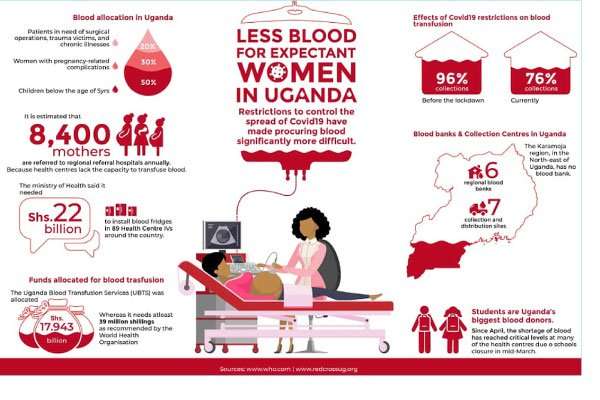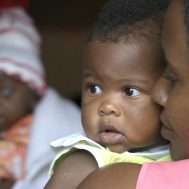No schools, no blood: How Covid-19 closure has worsened shortage
Written by BY GILLIAN NANTUME – September 7th, Daily Monitor , Uganda
Reproductive Health Uganda through the SET SRHR project is advocating for increased funding to the National blood bank. This is through a campaign dabbed Saving lives through greater investment in safe blood transfusion services. Join the conversation on social media using #SupportTheUGBloodBank #SaveLives #WeAreRHU

Blood transfusions are a strong pillar in modern medicine and they have saved the lives of countless people. Women with pregnancy related complications, need donated blood more than all other groups, except children below the age of five. Dr Elizabeth Nabiwemba, the project director of SET-SRHR, says blood loss mainly affects women in childbirth because their blood levels are already low due to the pregnancy.
Who is at risk
“Haemorrhage is the number one killer of pregnant women. When there is no blood in a hospital the risk of a woman dying in labour is very high. She does not have to lose much blood to die.”
Sarah Mutegombwa, the programme manager for blood donor recruitment at Uganda Red Cross Society (URCS) says most of the donated blood goes to children below five years.
“These children take at least 50 percent of the blood because they become anaemic when they suffer from severe malaria and malnutrition. Women with pregnancy-related complications take up 30 percent of the demand, while the remaining 20 percent is shared by those in need of surgical operations, trauma victims, and those who suffer from chronic illnesses, such as cancer and sickle cell disease.”
Mutegombwa adds that one unit of blood can serve three children, because they use only one or two components of the blood, such as red blood cells, platelets, or the plasma. An adult, though, can consume as many whole units of blood as the need arises. In contrast, in high-income countries about 76 percent of the donated blood is received by patient groups over the age of 65.
Before the COVID-19 pandemic dominated the focus of health policymakers, the Ministry of Health (MoH) had, in its 2020/21 budget, said it would target equipping Level IV Health Centres to provide blood transfusion services in order to improve reproductive, maternal, neonatal, child and adolescent health services.
According to the Health Ministerial Policy Statement for the Financial Year 2020/2021, it is estimated that 8,400 mothers are referred to regional referral hospitals annually because Level IV Health Centres lack the capacity to perform obstetric care as they cannot transfuse blood. The ministry said it needed Shs2.2 Bn to install blood fridges in 89 Level IV Health Centres around the country.
Chronic blood shortages worsened
There are seven blood collection and distribution sites located in the districts of Lira, Nebbi, Jinja, Masaka, Kampala, and Hoima. The collections sites are not fully-fledged blood banks because they do not have testing facilities. Restrictions to control the spread of the coronavirus have made procuring blood, even from these few points, significantly more difficult.
While anyone between 17- 60 years can donate blood as long as they are in good health, students are Uganda’s biggest blood donors.
“During the school term, we run continuous blood donation mobilisations to replenish what is in the blood banks, until the students get holidays. As a country, we have been getting 70 percent of our total blood donations from schools. The remaining 30 per cent is collected from the community. Some areas organise and then, call us, with the intention of donating blood,” Mutegombwa says.
She adds that in schools, more boys donate blood than girls. “For girls, the barriers to donating are many. For instance, she cannot donate blood if she has recently completed her period because she has lost blood. Also, in the communities, there are restrictions on a pregnant woman and breastfeeding mother donating blood.
However, when in terms of the HIV prevalence rate, we target low risk donors, where the rate of infection is too small. Before we go to a community, we screen its prevalence levels and also give community members information so they can self-exclude themselves.”
Blood has a shelf life of 35 days. Schools were closed in mid-March. Since April, the shortage of blood has reached critical levels at many of the health centres. This shortage gives unscrupulous health workers an opportunity to raise the price of the few units of blood available.
“During the holidays, we would shift the blood donation mobilisation drives to the communities. But, the pandemic broke out during the school term, so we had to quickly switch to the communities. Unfortunately, we ended up with a [total] lockdown,” Mutegombwa says.
Who has been donating?
With the broader lockdown came bans on public gatherings and public and private transport. URCS switched to soliciting for blood from individual registered donors.
Uganda has between 80,000 and 90,000 registered blood donors, most of who donate twice a year. Mutegombwa says: “We would call a donor, pick them from home and drive them to our offices. After the donation, we took them back home.
Sometimes, we spent one hour on transporting a donor. On average, we would pick up between 20 to 30 donors per day. Each of these can only donate one unit of blood every three months if they are male or every four months if they are female.”
Cost of blood supply
The government meets the costs of blood donation. But sometimes, especially during the lockdown, groups such as the Indian Association, offered to transport blood donors.
Although both public and private transport are operational, blood donations are still low due to the restrictions on public gatherings in communities, and also, due to the fact that schools are still closed. Mutegombwa says prior to Covid19, their outreach teams would hold at least 30-40 minute-long awareness campaigns in a month, targeting at least 100 people but now it is difficult to organise more than 20 people in one place.
The bleeding processes (drawing blood from a donor) also takes much longer. Previously, one nurse could tend to two donors at the same time. Now, due to the physical distancing and other Covid19 related regulations, a nurse will spend about 15 minutes bleeding one person.
Dr Mathias Lugolobi is District Health Officer in Wakiso. He says, “We have four government and eight church-based facilities that can perform blood transfusions. Ideally, each facility needs 30 blood units per month.”
However, they never get that many units and Lugoloobi adds that during the lockdown the blood supply dwindled to the bare minimum. When there are shortages of blood, smaller health centres outside the main urban areas are de-prioritised.
Dr Francis Kakooza, the Kayunga District Health Officer is also in charge of its general hospital. He says his hospital gets only about 15 to 20 units a week yet, ideally, they need 30 to 40 units. In times of shortages they do not get any blood from Nakasero blood bank.
“At times, we only get 10 units. So, we transfer patients who need blood to Jinja or Kampala districts. However, at the peak of the lockdown, we only made referrals to Kampala because in most cases, Jinja also suffered blood shortages. Right now, we are renovating the hospital and soon we will have an emergency trauma unit. This means we will need more blood,” he says.
The WHO standard
The Uganda Blood Transfusion Services (UBTS), the institution mandated to collect, test, store and distribute blood was allocated Shs17.824 billion (USD 4.8 million) in the 2020/2021 Financial Year. Of this amount, Shs 4.9 billion will go to wages and salaries, Shs 4.758 billion on travel and transport, Shs 2.675billion on general expenses, Shs 1.479billion on maintenance, and only Shs 476 million on supplies and services.
According to the World Health Organisation’s Global Database on Blood Safety, a country should be able to collect blood equivalent to one percent of its population. Uganda has an estimated population of 45,903,545 people.
This means the country needs to collect 459,035 units of blood annually. According to URCS, it costs USD85 (Shs 331,500) to collect one unit of blood. This means UBTS needs USD 39 million (Shs152.1 billion) if it were to meet the WHO recommendations. Mutegombwa says that the country is not set to meet the WHO target at the moment.
“Instead of the 459,035 units of blood, our target is 300,000 units a year,” she says.
That target, which translates into 25,000 units a month, is also often missed. By the end of last year, only 288,000 units had been collected,” she says.
Coronavirus restrictions made a bad situation worse. “Before the lockdown, as a country, we were at 96 percent collections. Currently, we are at 76 per cent. In April, only 14,768 units were collected, 23,032 units were collected in May and 19,050 units in June,” Mutegombwa adds.
Blood donation drive
The blood shortage has motivated medical doctors to fundraise for blood. Dr Joseph Gavin Nyanzi, the in-charge of Cherish Health Centre, a private-not- for-profit facility in Garuga, Wakiso district, has partnered with the Rotary Blood Bank at Mengo Hospital in a donation drive. Dr Nyanzi is also the public relations officer of the Uganda Medical Association.
“Over time, I have realised the need of blood as a medical product. So, on July 31, to commemorate my mother’s 70th birthday, I started a drive. My target is to collect 140 units of blood by September 3, when the drive will end. As of today (August 16) we have collected 20 units. Everyone is welcome to donate blood from Monday to Friday at the Rotary Blood Bank,” he says.
This is the second time Dr Nyanzi is carrying out a . In January last year, his drive had a target of 105 units but he managed to collect 16 units.
“There is only one factory of blood – you and I. If you donate blood, you also get the satisfaction of knowing your blood can make the different between life and death for someone,” he says.
Charting a way forward
On July 16, 2020, the UBTS appeared before Parliament’s health committee and requested for Shs20.5 billion to mitigate the blood shortage. Of this amount, Shs 10 billion wasww to offset a previous debt while the remaining Shs 10 billion was to help UBTS in the current crisis. The money has not yet been received.
However, there is a general feeling that UBTS is getting a lot of money but the problem is with prioritising how the money should be used. With prioritising blood collection, testing and distributing, the Ministry of Finance can be convinced when it comes to the supplementary budget. But the problem isn’t always financial. Mutegombwa says the majority of the registered donors are students.
“Adults fear donating blood because they do not want to know their HIV status. Some believe their blood supply will dwindle if they donate. Lack of information, discouraging cultural and religious beliefs about blood donation is also a hindrance. People see blood donation as taboo. They associate it with human sacrifice!” Mutegombwa says. Dr Nabiwemba says the general community should be mobilised.
“I know a woman who went to her church and talked to the congregants about the blood shortage. She asked them to bring other friends to donate blood in two weeks’ time and it was a successful donation. I think we can do this even in this era of social distancing. We can donate while observing the standard operating procedures.”
According to a Memorandum of Understanding signed between the Ministry of Health and URCS and UBTS, the two organisations are working with village health teams to register potential donors in rural areas.
To engage the public, the URSC has developed the Blood for Uganda App for both android and iOS which people can download and get to know the blood donation sites near them.
Mutegombwa says 114 donors have so far registered with the App. “When there is a need for blood from rare blood types, we activate the contacts in the App and they come to our offices to donate because most of them are walk-in donors.”
The app also creates a database of volunteers who can be reached in time of need and to achieve the No shortage of Blood goal. However, the App can only apply to people who use smartphones. Those who do not have them, have to rely on the honesty of medical workers.



